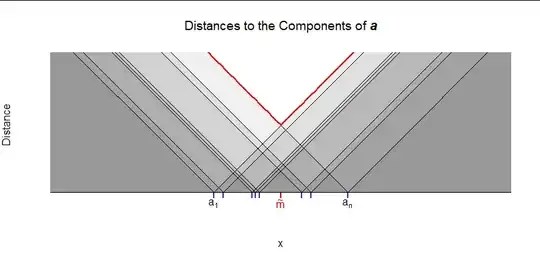Warning: crossposted at Mathematics SE.
Given vector ${\rm a} \in \Bbb R^n$,
$$\begin{array}{ll} \displaystyle\arg\min_{x \in {\Bbb R}} & \left\| x {\Bbb 1}_n - {\rm a} \right\|_2^2\end{array} = \frac1n {\Bbb 1}_n^\top {\rm a} \tag{mean}$$
is the (arithmetic) mean of the entries of vector ${\rm a} \in \Bbb R^n$, whereas
$$\begin{array}{ll} \displaystyle\arg\min_{x \in {\Bbb R}} & \left\| x {\Bbb 1}_n - {\rm a} \right\|_1\end{array} \tag{median}$$
is a median of the entries of vector ${\rm a} \in \Bbb R^n$. Using the $\infty$-norm instead, what is the following?
$$\color{blue}{\boxed{\,\\\begin{array}{ll} \displaystyle\arg\min_{x \in {\Bbb R}} & \left\| x {\Bbb 1}_n - {\rm a} \right\|_{\infty}\end{array}}}$$
It appears to be the mid-range. I append a proof based on linear programming. Assuming that I have made no mistakes and my proof is indeed correct, I am interested in other proofs and in references.
My proof
$$\begin{array}{ll} \underset{x \in {\Bbb R}}{\text{minimize}} & \left\| x {\Bbb 1}_n - {\rm a} \right\|_{\infty}\end{array} $$
Introducing optimization variable $y \in {\Bbb R}$,
$$\begin{array}{ll} \underset{x, y \in {\Bbb R}}{\text{minimize}} & \qquad\qquad y\\ \text{subject to} & -y {\Bbb 1}_n \leq x {\Bbb 1}_n - {\rm a} \leq y {\Bbb 1}_n\end{array} $$
or, alternatively,
$$\begin{array}{lrl} \underset{x, y \in {\Bbb R}}{\text{minimize}} & y & \\ \text{subject to} & {\rm a} & \leq (x + y) {\Bbb 1}_n \\ & (x - y) {\Bbb 1}_n & \leq {\rm a}\end{array}$$
Let the entries of vector ${\rm a} \in \Bbb R^n$ be denoted by $a_1, a_2, \dots, a_n$. Note that there are many redundant inequalities:
the set of $n$ inequalities ${\rm a} \leq (x + y) {\Bbb 1}_n$ can be replaced by $$x + y \geq \max \{ a_1, a_2, \dots, a_n \}$$
the set of $n$ inequalities $(x - y) {\Bbb 1}_n \leq {\rm a}$ can be replaced by $$x - y \leq \min \{ a_1, a_2, \dots, a_n \}$$
Subtracting the latter inequality from the former inequality,
$$y \geq \frac{ \max \{ a_1, a_2, \dots, a_n \} - \min \{ a_1, a_2, \dots, a_n \} }{2} =: y_{\min}$$
and, thus,
$$ \begin{aligned} x &\geq \max \{ a_1, a_2, \dots, a_n \} - y_{\min} = \frac{ \min \{ a_1, a_2, \dots, a_n \} + \max \{ a_1, a_2, \dots, a_n \} }{2} \\\\ x &\leq \min \{ a_1, a_2, \dots, a_n \} + y_{\min} = \frac{ \min \{ a_1, a_2, \dots, a_n \} + \max \{ a_1, a_2, \dots, a_n \} }{2} \end{aligned} $$
Hence,
$$\begin{array}{ll} \displaystyle\arg\min_{x \in {\Bbb R}} & \left\| x {\Bbb 1}_n - {\rm a} \right\|_{\infty}\end{array} = \color{blue}{\frac{ \min \{ a_1, a_2, \dots, a_n \} + \max \{ a_1, a_2, \dots, a_n \} }{2}}$$
Some call this value the mid-range of $\{ a_1, a_2, \dots, a_n \}$.
